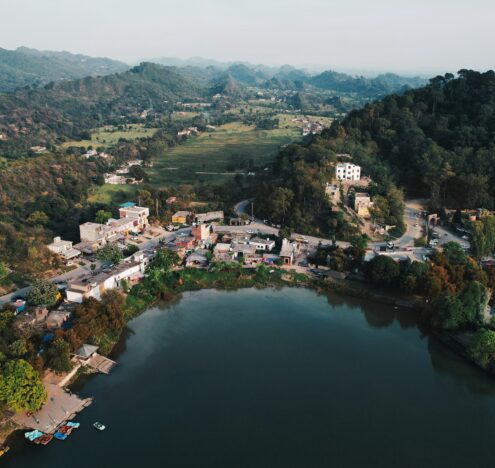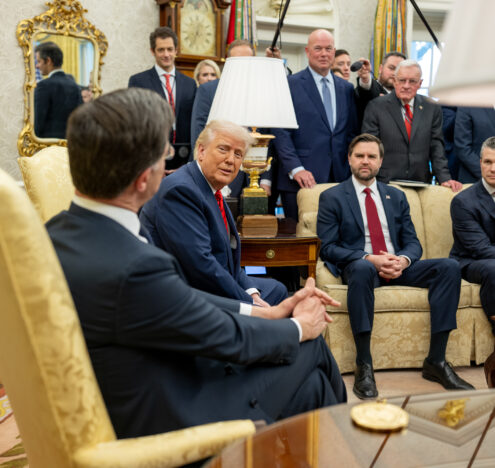This essay won the Stimson Center’s “Build a Better US Foreign Policy” student competition. The competition invited students to share creative ideas for improving US foreign policy to draw new and innovative talent into the policy space and provide avenues for young thinkers to engage with leading foreign policy institutions.
The push for modernization has led to an increasingly optimistic, yet problematic, vision for the future — a gap between ambition and funding that is estimated to leave a $15 trillion shortfall in global infrastructure investment by 2040. This problem provides a unique opportunity for the United States to rebuild its foreign reputation, demonstrate continued economic and political strength, and engage in well-meaning international action. The Department of State’s Blue Dot Network (BDN) could be the answer.
The network is a novel, robust mechanism to certify, support, and build infrastructure projects to international standards, assuring that the future of infrastructure investment does not fall victim to corruption and bureaucracy, particularly in the Global South. Since its founding in 2019, the BDN has had tremendous success in creating value not just for its investors and backers but also its community members, contractors, and neighbors.
Increasingly, the program is used to support economic war against China, undermining OECD allied relations who are not inherently looking for a fight with Beijing. Consequently, the US could best address its reputation problem through the Blue Dot Network by providing its own vision for human development, rather than as a direct response to China and its Belt and Road Initiative (BRI).
Boosting joint local-global private sector funding, forgiving International Monetary Fund (IMF)-owed debt in exchange for quality-controlled infrastructure projects, and fostering coordination among global private/public organizations and local entities could represent a more holistic and sustainable US strategy toward forging stronger international partnerships.
Countering Infrastructure Gaps
As digitization and demand for robust civil infrastructure rise (notably in telecommunications and energy), existing infrastructure is grossly inadequate to support such continued growth. The global investment shortfall is hence more pronounced as the gap between infrastructure needs and potential funding widens.
This shortfall persists despite recent spending bills during COVID-19. A failure to invest creates increasing pressure on areas including affordable housing, renewable energy, and zero buffered supply chains.
The consequences of infrastructure fragility was evident when the container ship Ever Given was jammed in the Suez Canal in 2021, a result of both pilot error and outdated infrastructure. The six-day blockage affected a crucial supply route responsible for 12-15% of worldwide trade: all due to an imbalance between growing supply chain needs and the inadequacy of current infrastructure.
Countering infrastructure gaps is crucial to global US interests, while ensuring an opportunity for durable, meaningful, and transparent foreign policy investment to improve America’s reputation.
Building Back (Even) Better
The Biden administration and G7 countries have implemented initial steps to address the investment gap through the Build Back Better World Initiative (B3W). The B3W has been presented, however, as the competitor to China’s BRI, threatening B3W’s long-term legitimacy.
Many projects are seen as strictly pro-China or pro-America with little to no option for investment otherwise. B3W is exclusively reliant upon the budgets of high-income states; however, these states have their own infrastructure needs to address. When balance sheets are tight, the obligations of high-income states shift to their internal infrastructure, which constrain resources for available projects, particularly in non-BRI countries. While B3W focuses on practical investment strategies, it fails to build local infrastructure capacity. Instead, the B3W relies upon high-income countries’ public investment, which is often inefficient or poorly targeted.
A failure to invest creates increasing pressure on areas including affordable housing, renewable energy, and zero buffered supply chains.
Many countries in the Global South lack the economic bandwidth or political energy to further engage with the US due to historically high sovereign debts to the IMF. While the IMF still holds economic power over the majority of sovereign debt, China is quickly catching up. The IMF still has the influence to forgive specified amounts of debt in exchange for compliance on Blue Dot Network projects, which provides a unique leverage opportunity. The BDN and IMF share the top nation shareholders, enabling like-minded cooperation (e.g., between Germany, US, Australia, and Japan).
While of little cost to American taxpayers, forgiving sovereign debt incentivizes economic efficiency and utilization on BDN projects that would otherwise be bogged down by adverse economic conditions.
An Opportunity to Shift
Infrastructure is a universal area of cooperation, enabling effective and widespread development when coordinated correctly. The BDN was constructed to directly counter the BRI – not just through the inclusion of “blue” language, to oppose BRI’s “red”. As a result, all but one BDN projects are also within BRI countries.
However, the US has an opportunity to shift tack. Unlike B3W, the BDN’s privately funded capital has been more effective, efficient, and locally equitable than exclusively public-funded initiatives, like B3W. Reorienting the BDN’s funding mechanisms to utilize joint local/global private investment for projects would simultaneously avoid inefficient investments and aid local capacity building, minimizing the initiative’s reliance on high-income countries. A vital component of this plan utilizes local and global private funding working together jointly, addressing issues of accountability, inefficiency, and corruption that are otherwise present with public investment.
This would nurture positive relations and collaborations with developing countries while growing quality infrastructure projects on a local and global scale — and, in doing so, advance shared approaches for infrastructure projects by compiling a large pool of diverse investment sources.
Enhancing Local Cooperation
To enable political, social, and cultural cooperation, the Blue Dot Network should identify, then empower local networks and labor for investment projects. This is partially accomplished through greater transparency into material and labor costs but is still inadequate to the vision of enhancing US international cooperation.
First, certified projects would need to create a predetermined number of local jobs, as opposed to utilizing foreign firms and labor — a typical catch of BRI projects.
Second, local projects should subscribe to public-private partnerships (PPPs) as effective governance structures that have robust monitoring frameworks that alleviate the intense corruption that follows many state-led bid style infrastructure projects.
Third, projects should continue to emphasize quality over grandeur, which is historically associated with higher levels of corruption. These adjustments would address the key problems associated with infrastructure projects, while strengthening US foreign policy foundations around the world.
By expanding the Blue Dot Network and shifting the focus away from direct competition with China, the US could provide a framework of quality and transparent infrastructure modernization while rebuilding its damaged reputation. The US’s assuredness in infrastructure investment could substantially drive progress toward UN human development outcomes and demonstrate America’s capacity for confident, compassionate, and transparent global leadership.




















